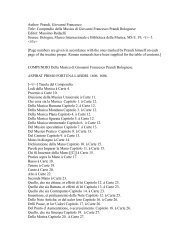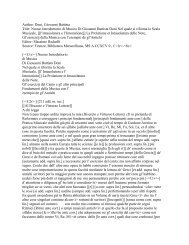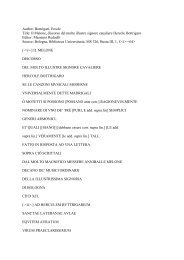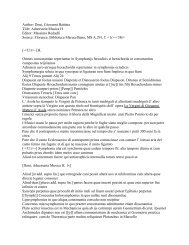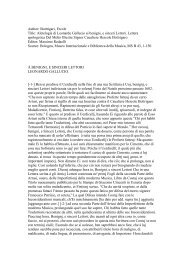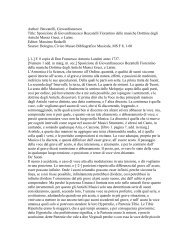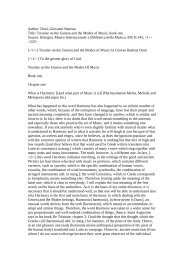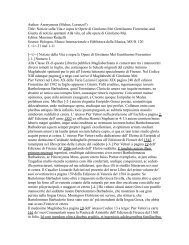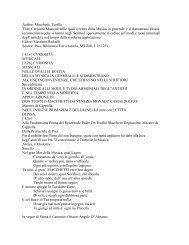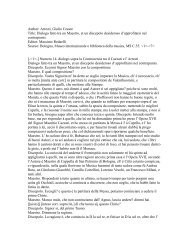Author: Dentice, Luigi - manuscripts of italian music theory in ...
Author: Dentice, Luigi - manuscripts of italian music theory in ...
Author: Dentice, Luigi - manuscripts of italian music theory in ...
You also want an ePaper? Increase the reach of your titles
YUMPU automatically turns print PDFs into web optimized ePapers that Google loves.
more tightly, its pulsation is faster, it oscillates more frequently and more frequently and<br />
thickly it hits the air. When the str<strong>in</strong>g is more relaxed, its pulsations are more relaxed and<br />
slow, and, because it hits the air less strongly, it does so also less frequently. Nor should<br />
you th<strong>in</strong>k that the sounds correspond to the number <strong>of</strong> times that the str<strong>in</strong>g is hit, or as<br />
many as the percussions that occur on the str<strong>in</strong>g, but the air will be hit as may times as it<br />
is hit by the trembl<strong>in</strong>g note. However, s<strong>in</strong>ce the speeds <strong>of</strong> the sounds approach each other<br />
and are fused together to such a great extent, therefore the ear cannot hear anyth<strong>in</strong>g but a<br />
low or high sounds, although each consists <strong>of</strong> several ones, the low one <strong>of</strong> the slowest and<br />
most <strong>in</strong>frequent ones and the highest one <strong>of</strong> the fastest and most frequent ones.<br />
Serone. Therefore, if the high sounds are produced by fast and frequent motions, and the<br />
low one by slow and <strong>in</strong>frequent ones, [-f.7r-] it is necessary that, if the motions are<br />
<strong>in</strong>creased, they should progress from the low to the high register, and conversely, if the<br />
motions are decreased, that they should progress from the high to the low register.<br />
Soardo. It is so, because a high sounds consists <strong>of</strong> more motions than a lowe one. The<br />
larger number <strong>of</strong> these creates this difference, and it must necessarely consist <strong>in</strong> some<br />
number. Every small quantity compared to a large one are represented by the comparison<br />
between two numbers, and all the quantities that are compared accord<strong>in</strong>g to numbers,<br />
some are equal between each other and others are separated by their be<strong>in</strong>g unequal. There<br />
can be no consonance <strong>in</strong> any way <strong>in</strong> the notes that do not differ accord<strong>in</strong>g to any<br />
<strong>in</strong>equality, because the consonances is the result <strong>of</strong> notes that are different one from the<br />
other and are reduce to concord.<br />
Serone. You are giv<strong>in</strong>g me life. Please cont<strong>in</strong>ue.<br />
Soardo. All <strong>music</strong>al consonances consist either <strong>in</strong> the dupla, tripla, quadrupla, sesquialtera<br />
or sesuqitertia proportion. The <strong>in</strong>terval represented <strong>in</strong> numbers by the sesquitertia<br />
proportion is called diatessaron, which means fourth. The one represented <strong>in</strong> numbers by<br />
a sesquialtera, is called diapente, as an <strong>in</strong>terval, which means fifth. The one represented<br />
by the dupla proportion is called diapason, as a consonance, which means octave. The<br />
tripla proportion is called diapente and Diapason as a consonance, or twelfth. The<br />
quadrula is called bisdiapason or fifteenth.<br />
Serone. These words are not new to me because I have heard them <strong>of</strong>ten used by men<br />
expert <strong>of</strong> <strong>music</strong> and I rema<strong>in</strong>ed surprised that they do not prefer to use our own terms,<br />
s<strong>in</strong>ce they satisfy the mean<strong>in</strong>g <strong>of</strong> mean<strong>in</strong>g completely.<br />
Soardo. You are correct, but this is how they learned them <strong>in</strong> that studies. Moreover, they<br />
want to honour the language <strong>in</strong> which that art was first taught.<br />
Serone. It seems to me that they should honour much more our art, especially where it is<br />
able to receive and illustrate the mean<strong>in</strong>g. However, to avoid obstruct<strong>in</strong>g [-f.7r-] the flow<br />
<strong>of</strong> the reason<strong>in</strong>g that was started, tell me, how were the measures <strong>of</strong> the consonances<br />
discovered<br />
Soardo. I will tell you this, although it appears that the entire basis <strong>of</strong> this art <strong>of</strong> <strong>music</strong><br />
appears to consist <strong>in</strong> the sense <strong>of</strong> hear<strong>in</strong>g, because <strong>in</strong> no way one could discuss the notes<br />
without it. Nevertheless, everyth<strong>in</strong>g else about the perfection and strength <strong>of</strong> perception<br />
has its roots with<strong>in</strong> reason, which, as it is based on true and certa<strong>in</strong> rules, cannot deviate<br />
from the truth <strong>in</strong> any way. The same does not occur <strong>in</strong> the case <strong>of</strong> the senses, because not<br />
everybody has the same capacity to understand, nor this capacity is always constant<br />
with<strong>in</strong> man. Therefore, those who pursue the truth <strong>in</strong> every matter do less then well <strong>in</strong><br />
entrust<strong>in</strong>g this variable judgement. This is why the Pythagoreans adopted the middle way,<br />
because they did not assign the entire task <strong>of</strong> judg<strong>in</strong>g to the ears, but also they made most<br />
<strong>of</strong> their discoveries with the help <strong>of</strong> the ears. Therefore, the consonances are measured<br />
with the sense <strong>of</strong> hear<strong>in</strong>g, but, as to the distance by which they differ, this judgment is not<br />
entrusted to the ear, whose judgement is cloudy, but to the rules and to reason <strong>in</strong>stead.



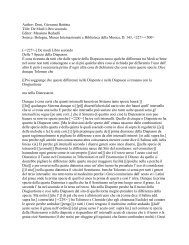
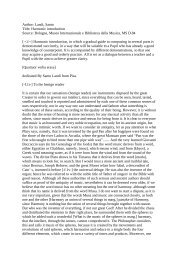
![Doni, Giovanni Battista Title: Trattato Dei Tuoni o [[Harmonie de]]](https://img.yumpu.com/45461005/1/190x245/doni-giovanni-battista-title-trattato-dei-tuoni-o-harmonie-de.jpg?quality=85)
